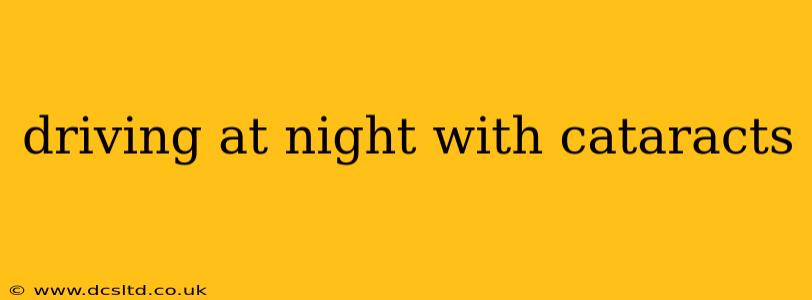Driving at night can be challenging for anyone, but for individuals with cataracts, it presents a significantly heightened level of risk. Cataracts, a clouding of the eye's lens, significantly impact vision, making nighttime driving particularly hazardous. This comprehensive guide explores the difficulties faced by cataract sufferers driving at night, offers solutions, and emphasizes the importance of safety.
What Makes Night Driving Difficult with Cataracts?
Cataracts scatter and absorb light, leading to several vision problems that dramatically worsen at night:
-
Glare: Bright headlights from oncoming traffic or even streetlights can be intensely blinding, causing significant discomfort and reduced visibility. The scattered light makes it difficult to distinguish objects and perceive depth.
-
Reduced Contrast Sensitivity: Cataracts make it harder to differentiate between objects of similar brightness, hindering the ability to discern pedestrians, cyclists, or even road markings in low-light conditions.
-
Halos and Starbursts: Light sources may appear surrounded by halos or starbursts, further distorting vision and making it difficult to focus.
-
Night Blindness: Some individuals with cataracts experience a worsening of their night vision, making it nearly impossible to drive safely after dark.
How Does Cataract Severity Affect Night Driving?
The impact of cataracts on night driving varies considerably depending on the severity of the condition. Mild cataracts may cause only minor inconveniences, while advanced cataracts can render night driving extremely dangerous and virtually impossible. Regular eye exams are crucial for monitoring cataract progression and assessing driving safety.
What are the Safety Risks of Driving at Night with Cataracts?
Driving at night with cataracts significantly increases the risk of accidents. The impaired vision can lead to:
- Increased reaction time: The difficulty in perceiving objects and judging distances leads to slower reaction times, increasing the chance of collisions.
- Difficulty in judging distances: This can result in improper braking or lane changes, leading to accidents.
- Reduced awareness of surroundings: The inability to clearly see pedestrians, animals, or other vehicles can lead to unexpected and dangerous situations.
Can I Still Drive at Night with Cataracts?
This is a question best answered by your ophthalmologist. They can assess the severity of your cataracts and determine if your vision is sufficient for safe night driving. It's crucial to be honest and upfront about your vision challenges. Your doctor's recommendation should always prioritize your safety and the safety of others.
What are the Alternatives to Driving at Night with Cataracts?
If your doctor advises against night driving, several alternatives can help maintain your independence:
- Adjusting your schedule: Plan your trips during daylight hours whenever possible.
- Using public transportation: Buses, trains, and subways offer safe and convenient alternatives.
- Relying on ride-sharing services: Services like Uber and Lyft provide safe and readily available transportation.
- Enlisting the help of friends and family: Ask loved ones for assistance with nighttime errands or travel.
What Treatment Options are Available for Cataracts?
Cataract surgery is a highly effective and safe procedure that can significantly improve vision. The surgery involves removing the cloudy lens and replacing it with an artificial intraocular lens (IOL). Many patients experience a dramatic improvement in their vision, including night vision, after cataract surgery.
How Can I Improve My Night Driving with Mild Cataracts?
While cataract surgery is often the most effective solution, several strategies might help improve night driving with mild cataracts:
- Drive on well-lit roads: Avoid poorly lit roads and highways whenever possible.
- Use anti-glare driving glasses: These can help reduce glare from oncoming headlights.
- Increase your following distance: This allows for more time to react to unexpected situations.
- Avoid driving when fatigued: Fatigue exacerbates vision problems, making driving more dangerous.
What are the signs I need to see an ophthalmologist about my cataracts?
If you are experiencing any of the above-mentioned difficulties with night driving, along with blurry vision, cloudy vision, faded colors, halos around lights, or double vision, it’s crucial to schedule an appointment with an ophthalmologist for a comprehensive eye exam. Early detection and treatment can help preserve your vision and ensure your safety.
This information is for educational purposes only and should not be considered medical advice. Always consult with your ophthalmologist or other qualified healthcare professional for diagnosis and treatment of any medical condition. Your safety and vision health are paramount.
